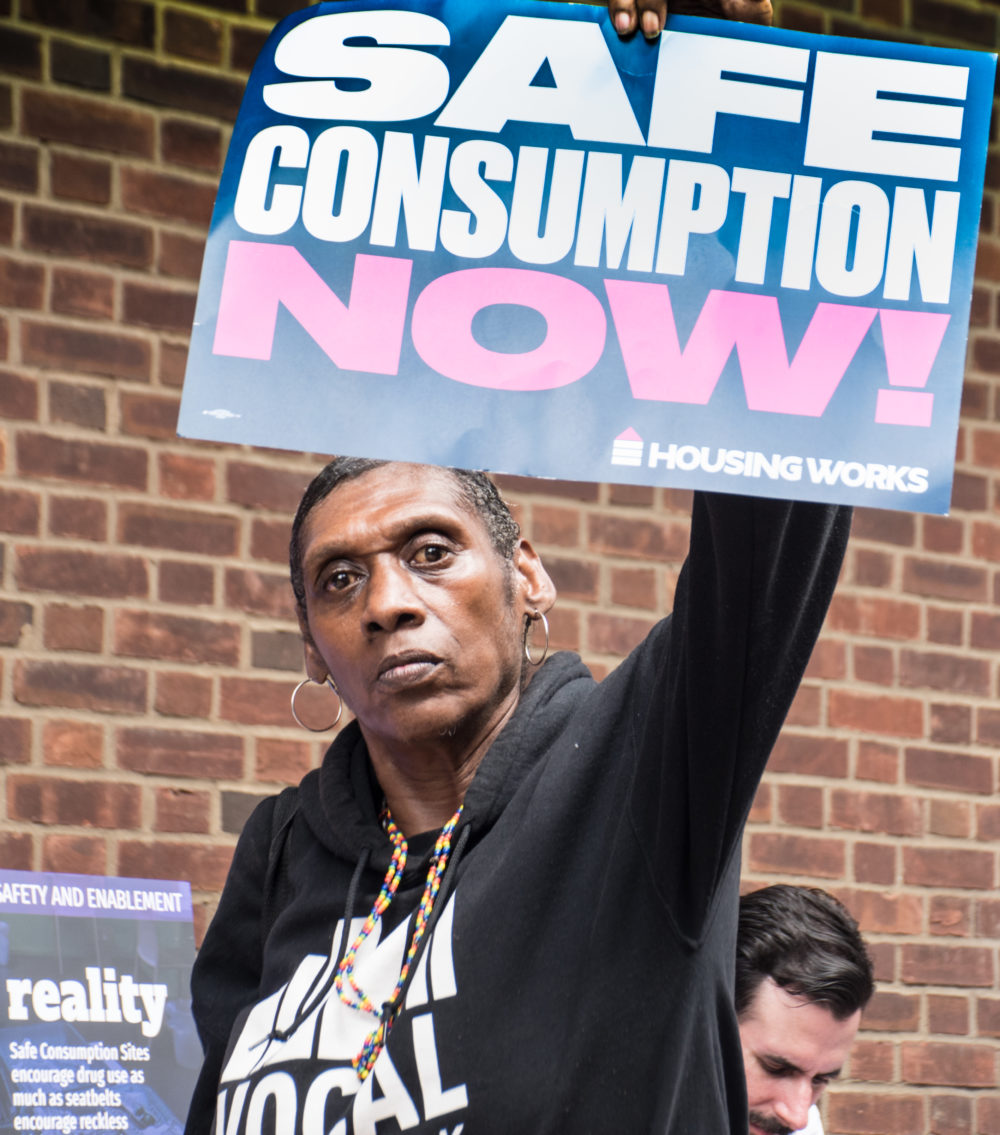While jailed on drug charges at New York City’s Rikers Island in 1994, Marilyn Reyes received medical treatment to curb her heroin addiction. But once Reyes, then in her 20s, was convicted and transferred to an upstate prison, she stopped getting the medications prescribed to help her overcome what's since been labeled as opioid use disorder.
“It was the most traumatizing, horrible experience I ever had,” said Reyes, now co-director of Peer Network of New York, which provides, among other services, needle exchanges to reduce some of the health hazards of using illegal drugs.
 “I went through horrible withdrawals,” she said, describing the pain she endured when those prescribed anti-addiction meds were abruptly halted. “I would sleep under the cot on the cold floor and pull out my hair because I was in so much agony.”
“I went through horrible withdrawals,” she said, describing the pain she endured when those prescribed anti-addiction meds were abruptly halted. “I would sleep under the cot on the cold floor and pull out my hair because I was in so much agony.”
That forced withdrawal resulted from the fact that upstate Albion Correctional Facility didn’t have a medication-assisted treatment program similar to the one at Rikers. Even today, such treatment is offered at seven or eight of the state’s 50 prisons, according to a July 2021 report by Georgetown University Law School’s O’Neill Institute for National and Global Health Law. At least 42 county jails statewide, plus Rikers Island, whose catchment area is the five counties comprising New York City, had medication-assisted treatment as of March 2021, according to the New York Office of Addiction Services and Supports.
But, under a law scheduled to take effect next year, each of New York’s jails and prisons are slated to establish medication-assisted treatment programs for substance use disorders, including opioid addiction. The 2021-22 New York State budget allocated $11 million to prisons and $8.75 million to county jails for implementing the treatment programs. Counties without sufficient funding or personnel to administer those programs can apply for a waiver.
“We are working with facilities to get them the funding and resources they need to implement this program,” Evan Frost, assistant director of communications and public information for the state's addiction services and supports office, wrote in an email. “We hope to get these programs up and running as soon as possible.”
Recent court-ordered opioid settlements might also direct funds into medical and other efforts to mitigate the opioid crisis’ impact on the criminal justice system.
Most incarcerated people nationwide either used or were criminally involved with drugs
The National Institute on Drug Abuse has reported that 85% of incarcerated individuals have an active substance use disorder or were incarcerated for crimes involving drugs or drug use.
More than 10% of deaths in jails, which mainly house pre-trial detainees, involved drugs or alcohol, according to “Over-Jailed and Un-Treated,” a June 2021 report from the American Civil Liberties Union.
Medication-assisted treatment reduces the risk of death by 85% and the risk that a person will die of an overdose in the weeks following release from incarceration by 75%, according to the ACLU report, which also concluded that 25% of U.S. prison and jail inmates had an opioid use disorder.
Addiction treatment combines FDA-approved medications and counseling
Evidence-based, backed and overseen by the federal Substance Abuse and Mental Health Services Administration, medication-assisted treatment for substance use disorders combines FDA-approved drugs with counseling and behavioral therapies.
As treatments for, as one example, opioid addiction, buprenorphine, methadone and naltrexone aim to mitigate the vomiting, drug cravings, anxiety, bodily aches and severe pains that can accompany withdrawal.
In an analysis published in January 2021 in Pediatrics, Columbia University researchers Selen Siringil Perker and Lael E. H. Chester cited prior research regarding the particular perils that 18- to 25-year-old substance users confront. (A 2019 analysis in Health Affairs noted that two of three persons treated for opioid addiction was aged 25 and younger.) As one example, the Columbia researchers noted that one in three opioid-addicted persons in that age group had received medications to stop using opioids.
Youth of color and women, however, were significantly less likely than others to be prescribed the appropriate medications, the Columbia researchers noted. For persons in the criminal justice system, those disparities were even wider.
“Research also indicates that young people of color are more likely to be criminalized for [substance use disorders] and then put in a system that’s in no way designed to promote their recovery,” Perker, senior advisor for the Emerging Adult Justice Project at Columbia University’s Justice Lab, wrote in an email.
New law requires correctional facilities to give inmates, pre-release, a short supply of medication and community-based treatment referrals
The new law also requires treatment programs to provide those preparing for release with information on available community-based treatment facilities and a one-week supply of medications that were prescribed during their incarceration.
“Individuals leaving jails and prisons are between 10 and 40 times more likely to die of an opioid overdose than the general population — making them one of the highest at-risk groups for opioid overdose,” the Georgetown Law researchers wrote. “This risk is especially acute three to four weeks post-release.”
Ensuring community-based care for those who were treated for substance use behind bars is crucial to lowering rates of addiction relapse and criminal recidivism, including for formerly incarcerated young adults, said Perker, adding that relapse should be medically treated, not criminally punished.
“One significant driver of mass incarceration in the U.S. is technical violations of parole and probation, such as failing a drug test,” Perker said. “One study found that substance use was included in 50% of such technical violations.”
Medication-assisted treatment pared recidivism in an upstate New York jail
Partnering with several nonprofit and government agencies, Sheriff Craig Apple, in 2019, implemented a medication-assisted treatment program in the Albany County Jail, which he oversees.
Its recidivism rate was 6.8% for those enrolled in the program, where roughly a quarter of participants are between the ages of 20 and 29, according to data from the New York State Department of Health. The overall recidivism rate for Albany County Jail had been between 44% and 47%, Apple said.
Because many re-entry programs in the Albany area focus on those released from state prisons and not county jails, Apple said, his office has been building its own relationships with local reentry and health organizations. It does “soft hand-offs” to local treatment centers of persons being released from jail in hopes that they'll continue treatment in their communities.
That collaboration represents an about-face for the sheriff. He’d been against implementing a treatment program until he spoke with then-Katal Center Director of Health and Harm Reduction Keith Brown, said Apple, adding that law enforcement and advocacy groups often have clashed on topics ranging from bail reform to medication-assisted treatment programs.
Now, Apple said, 0f medication-assisted treatment, “It works. It’s one of the most successful programs I have.”
Will bias adversely affect New York’s upcoming treatment programs?
Stigma around medication-assisted treatment and substance use disorders could be barriers to implementing the new law well, Perker said. Racial, ethnic and gender disparities in diagnosing and prescribing medications might also prevent effective implementation.
To better understand and address these disparities, she said, it is essential to establish evidence-driven assessments of the set-up and outcomes of treatment programs provided during incarceration and when people leave prison or jails. Especially regarding young adults, those efforts should include job and housing placement supports and pairings with mentors.
“Evidence suggests that existing addiction treatment programs in the adult criminal justice system are insufficient to address [substance use disorders] for all age groups,” Perker and Chester wrote in the January analysis in Pediatrics.
For younger persons whose transition into adulthood isn’t smooth, those systemic shortcomings may have even worse impacts. The American Academy of Pediatrics, which publishes the journal, has pushed for pediatric care to continue at least through age 21. So, Perker said, incarcerated persons should receive medical treatment for substance use disorders under a pediatric model.
She and her research partner recommend providing those young adults with individualized rehabilitative services, including developmentally and age-appropriate behavioral health services, addiction treatment, vocational training and confidentiality protections that juveniles otherwise receive.
Sheriff: Some jails may resist implementing medication-assisted treatment
While Sheriff Apple said he is pleased with what his facility’s medication-assisted treatment is yielding, he is concerned that some jails will want nothing to do with such a project: “They’re going to have, I’m assuming, a laissez-faire approach towards it … ”
His agency paid for medication-assisted treatment by several means, including reallocating salaries from vacant positions in the sheriff's department.
To gain buy-in for potentially hesitant county jail officials, he suggests a regional approach that also might be more financially prudent. Rather than having each county implement treatment in its jails, Apple said, resources might be more efficiently used by having one county provide, in a single location, medication-assisted treatment for inmates from a collection of nearby counties.
Setting aside how the programs are implemented, it’s important that the programs be well-advertised to incarcerated people, said Biz Berthy, drug policy campaign coordinator at VOCAL-NY, a statewide organization that has lobbed for drug law and criminal justice reforms.
“It’s not uncommon for people in any scenario to only realize, … once it’s too late, that they were entitled to something,” she said.
Researcher: Preventative programs might keep young adults with addiction out from behind bars
Confronting substance use disorders as a public health issue requires new policies and programs aimed at diverting young adults and others with addiction from the criminal justice system, some observers contend.
For example, Columbia's Perker said, research has shown that medication-assisted and other treatments for substance use disorders is most effective when those 18- to 25-year-olds, referred to in her research as emerging adults, get preventative treatment in their own communities, long before any of them verge on being arrested or incarcerated.
For its part, VOCAL-NY is working on legislation to decriminalize low-level possession of drugs, hoping that will prevent people from cycling in and out of the state’s prisons and jails. Non-violent drug violations are included in a category of low-level offenses that the Vera Institute, in its 2019 "Every Three Seconds" report, said account for 80% of all police arrests nationwide.
Berthy added, “Even if [the law] is perfectly implemented, we’re still really dedicated to finding ways to de-carcerate effectively and quickly, because we don’t want to be dumping all of the state’s money for harm-reduction resources into jails and prisons.”
Part of Reyes’s work at Peer Network involves meeting individuals who’ve overdosed and landed in hospital emergency rooms. She schedules follow-ups for 90 days after that emergency admission and connects them with harm-reduction and other services.
“I just ask them what they need and then link them to whatever it is they want,” she said.
A number of people she’s seen succeed, after getting their chosen treatment, are young adults. Receiving treatment for a substance use disorder in jail or prison “could open the door for them to have when they come out to have a better life,” she said. “It saves lives… and it gives them choices.”
